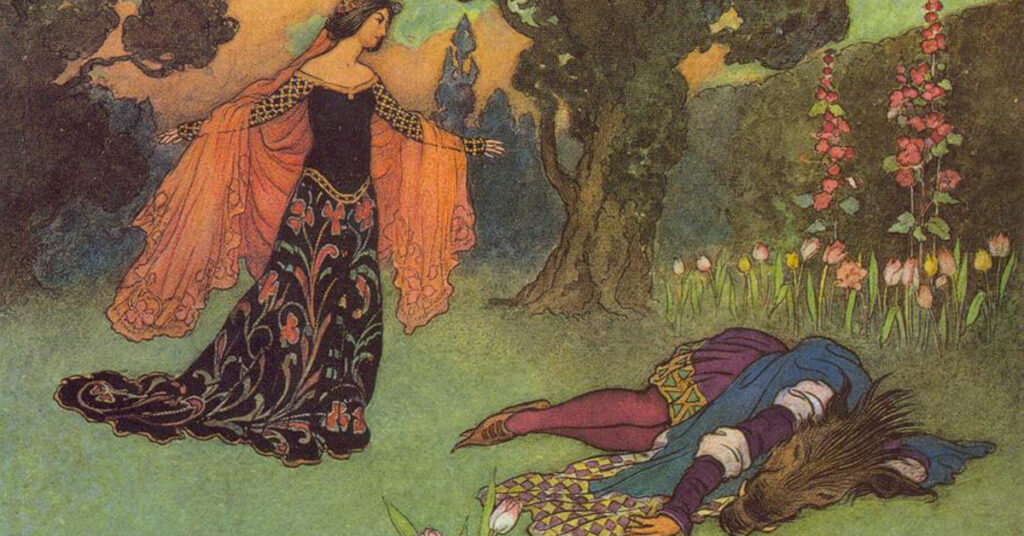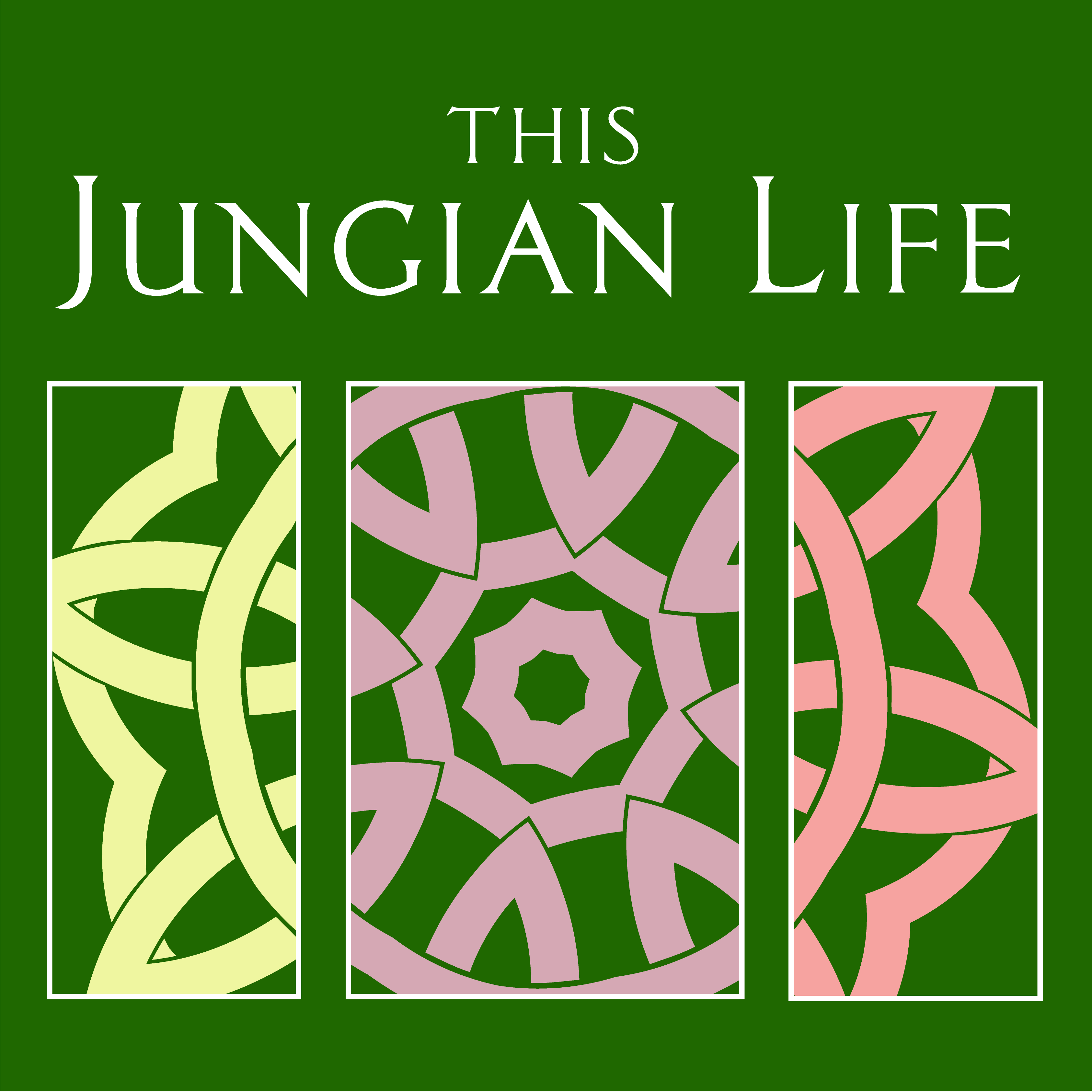
The tale of Beauty and the Beast is at least 4,000 years old, perhaps second in popularity only to Cinderella. It has generated many print versions, animated films, a Broadway show, and a Disney film. What about this tale continues to ensure its popularity? And what is this tale really about?
Beauty and the Beast is a metaphor for the development of the feminine, symbolized by an animal bridegroom—who, of course, is an enchanted prince. It’s tempting to see this tale as an example of women treated as chattel by misogynistic males, but as our archetypal bones, fairy tales show us universal problems, patterns, and psychic realities. Beauty’s task is to relate to her instinctual self, represented by the beast. Each of us has an inner other, often imaged as opposite sex, who possesses qualities that seem utterly foreign yet compel attention and interaction.
The tale begins with Beauty’s father stealing a rose for his favorite daughter from the beast’s garden. Outraged, the beast demands retribution: either the father or one of his daughters must agree to live with the beast. Beauty, described as “loyal and modest,” loves her father and insists on sacrificing herself to the beast, who they believe will kill her. A seemingly simple rose comes at a high price, and representations of masculine figures are negative: feckless father and fiend. However, the rose is a mandala. It opens like the lotus from a center and holds the promise of wholeness.
We see the interplay of opposites at the outset and throughout: Beauty’s innocence and self-sacrifice contrast with the beast’s domineering will. Beauty’s seemingly loving father is powerless and unable to protect her, but the beast provides for her every want despite her nightly refusal to wed him. In the beast’s domain, naïve and compliant Beauty discovers her power of self-determination: she stands up to the beast as she did not do with her father, and the beast agrees to let her visit her family. Given freedom from obligation, she chooses to return to the beast.
Beauty’s realization reflects her newfound ability to base loyalty on character and consciousness rather than reflexive filial duty. She needed to access autonomy, and her primal inner other—the beast–needed to relinquish control. Beauty and the Beast is a heartening tale of hard-won wholeness—and at its center is love.
HERE’S THE DREAM WE ANALYZE:
“I am at a social function in a chic, minimal, modern venue. The attendees include some close friends, notably my mother and one of my best friends (I’ll call her Jane). The chefs at the function make gorgeous food out of flowers and something resembling gelatin. At a certain point, the chefs call me over to give me a special thing. They hand me a translucent green jelly orb with a purple flower resembling witch alder suspended in the center. It is clear to me that I am meant to pass the orb around to the party attendees. As they pass it around, most members only touch it, but once it gets to Jane, she puts the flower in her mouth and pulls it out like a lollipop.”
BECOME A DREAM INTERPRETER:
We’ve created DREAM SCHOOL to teach others how to work with their dreams. A vibrant community has constellated around this mission, and we think you’ll love it. Check it out.
PLEASE GIVE US A HAND:
Hey folks — We need your help. So please BECOME OUR PATRON and keep This Jungian Life podcast up and running.
SHARE YOUR DREAM WITH US:
SUBMIT YOUR DREAM HERE FOR A POSSIBLE PODCAST INTERPRETATION.
FOLLOW US ON SOCIAL MEDIA:
FACEBOOK, INSTAGRAM, LINKEDIN, TWITTER, YOUTUBE
INTERESTED IN BECOMING A JUNGIAN ANALYST?
Enroll in the PHILADELPHIA JUNGIAN SEMINAR and start your journey to become an analyst.
LET’S STAY in TOUCH:
SUBSCRIBE to our free newsletter.

Hello Deb and Lisa,
I enjoyed this episode. I’m a French teacher and I’ve been teaching Beauty and the Beast films and literature for many years. Might I recommend the following films:
Jean Cocteau’s 1946 film La Belle et la Bete (in French with English subtitles)
Phantom of the Opera – the 2004 film with Gerard Butler
Cyrano de Bergerac (the Jean-Paul Rappeneau 1990 film with Gerard Depardieu as Cyrano) An EXCELLENT, beautiful film.
Roxane – starring Steve Martin. It’s a comedy take-off of Cyrano de Bergerac. Amusing!
Edward Scissorhands – with Johnny Depp as the beast.
Moonstruck – with Nicholas Cage and Cher. Yes, it’s a Beauty and the Beast movie and some serious mother complexes there, too!)
Penelope – In this version, it’s the girl who is the “beast.”
The Shape of Water (You’ve done an episode on this, I know.)
V for Vendetta – This is an extremely complex Beauty & the Beast film with deep themes and symbolism. Highly recommended.
The Disney film Beauty and the Beast. In this version, an old witch changes the prince into a beast because he rebuffs her.
In terms of literature, Nathaniel Hawthorne’s short story “The Birthmark” comes to mind.
Deb, I believe that the Phantom was redeemed. In the end, he is redeemed through her kiss and frees her. He puts her freedom above his love for her and his desire to keep her with him in the underground (in the dark). There is a lot of light/dark symbolism especially in Cyrano and Phantom of the Opera. I would also suggest the books The Meanings of Beauty and the Beast: A Handbook by Jerry Griswold and Marina Warner’s book From the Beast to the Blonde. They’re not Jungians but definitely give some interesting perspectives. Thanks for another interesting episode!
I could also add that in many versions Beauty must choose between a handsome man who acts beastly and a beastly looking man who acts beautifully. This is especially evident in the Disney film, Cyrano, Edward Scissorhands and Phantom. So, in some versions there is a choice that Beauty must make between the suitors. Also, the Beast in many versions has “special” and endearing qualities – he is poetic or a musical genius or he can make wonderful topiaries with his scissor hands or he loves literature and art as in V for Vendetta. I would say that these are qualities of the Beast’s soul which Beauty eventually comes to love. She learns to see through the physical appearance to the Beast’s very soul. 🙂
Hello Deb and Lisa, lovely episode. I would love to know if there is a episode based maybe in another story tale that exemplifies well the masculine perspective and the psyche forces leading to a integration in the case of similar wounds maybe mother related.
Maybe there is already one episode where that was addressed. if so would do kindly point me out to it?
I really admire your work, I am taking the dream school and I am also learning so much, thanks for all those initiatives.
May you all be well, Andreia
Amazing interpretation of a flower , whole ness at the outset and throughout. Self sabotage and self rage need to be adddressed
Hello Deb and Lisa, I loved this episode, what a special interpretation. I was wondering if you made before any episode also based on a tale about the masculine view on the potential wounds. A kind of equivalent to this episode from the masculine perspective.
I would appreciate if you can point me out to the video.
Many thanks once again for the amazing episode.
If I can be so bold (everyone “else” seems on vacation)….
I would recommend the fairytale Jack and the Bean Stalk which is mentioned in this TJL episode on hiding:
https://thisjungianlife.com/episode-46-hiding/
I would also recommend – without the fairytale though – the TJL episode on the negative mother complex:
https://thisjungianlife.com/episode-75-negative-mother-complex-when-our-painful-childhood-owns-us/
If you search “Jung/ian interpretations on Jack and the Beanstalk,” there are many good interpretations which deal with his mother complex.
So, Jack is missing his dad and is lazy. The cow sold for giving no milk is a sign of being weaned off mother’s milk. An eternal child, Jack has to grow up and find a balance between his boyhood and the giant’s exaggerated masculinity.
I liked Adam Phillips’s Freudian interpretation of the tale:
https://www.theguardian.com/books/2007/dec/01/booksforchildrenandteenagers.theatre
Good luck!